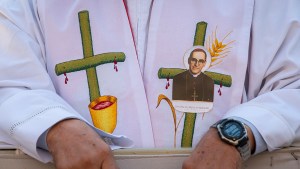Lenten Campaign 2025
This content is free of charge, as are all our articles.
Support us with a donation that is tax-deductible and enable us to continue to reach millions of readers.
The classic procedure for beatifications and canonizations was established by Pope Benedict XIV in the 18th century, and is still the standard today. With a few exceptions, such as martyrs, the Church does not recognize blessed or saints unless there has been a physical miracle — psychological or neurological ailments are not considered — attributed to their intercession.
Indeed, to beatify or canonize a baptized person, “it’s not enough to have a well-constructed dossier; there has to be a sign that doesn’t depend on us, that comes from God. A confirmation that Providence comes to offer us,” explains Fr. Bernard Ardura, president emeritus of the Pontifical Committee for Historical Sciences, and postulator of the cause of canonization of St. Charles de Foucauld.
In the long march toward the recognition of a miracle, we must first find an event that cannot be explained scientifically. Even if there are “technical” miracles such as “escaping danger,” a very high percentage are healings, says the French Premonstratensian.
Diocesan investigation
The first part of the official procedure, the canonical investigation, takes place in the diocese where the alleged miracle occurred. The bishop, contacted by the postulator, must set up an informative tribunal — made up of the bishop or a delegate, a promoter of justice, a notary, a clerk and a doctor — which gathers all the documentation. Two doctors — or engineers, as the case may be — are appointed to independently examine the person receiving the “alleged miracle.” Their testimony will then be heard by the court. The aim is to establish that the recovery is complete, lasting, and without recurrence, when the prognosis was hopeless despite whatever medical intervention may have been tried.
Witnesses to the event are also heard, as well as witnesses to prayers addressed specifically to this venerable or blessed. The scientific element is not enough. “Miracles are a theological category. They can only happen if we ask for them,” Fr. Ardura emphasizes. Once everyone has been heard, the file is sent to Rome.
The Roman stages
First, the Dicastery for the Causes of Saints verifies all the documents in the case in order to issue the decree of legal validity. Once this document has been obtained, the postulator must prepare the first part of the “positio,” a thesis containing the facts and testimonies, to prove that this is a scientifically inexplicable fact that can be qualified as a miracle.
The technical medical part of the positio is first examined by two independent scientists. If their two opinions are in agreement, the case is passed on to the “consulta medica”: a commission of seven doctors, who must decide on the case. “We want unanimity, but we accept that there may be one or two voices that do not completely share the opinion of the others,” explains Fr. Ardura.
If the fact is recognized as “inexplicable,” the religious aspect of the case, containing testimonies of prayers, requests for intercession, and any spiritual recommendations, is entrusted to nine theological consultants. They have to decide whether it was a miracle of God obtained through the intercession of the venerable or blessed saint.
All the way to the pontiff
The positio containing the results of all the commissions is submitted to the cardinals and bishops who are members of the dicastery, who will give their final opinion. It is this opinion that is finally presented to the pope by the prefect of the dicastery, currently Cardinal Marcello Semeraro. The pope then must decide to approve the publication of a decree attesting to the miracle, opening the door to beatification or canonization.
Generally speaking, the diocesan process takes a few months, while the Roman stages can take between two and four years.
Are miracles rare? While the Church is cautious, recognizing only a few a year after exacting procedures, “this is a tiny minority compared to everything else that happens in the world,” Fr. Ardura assures us.



